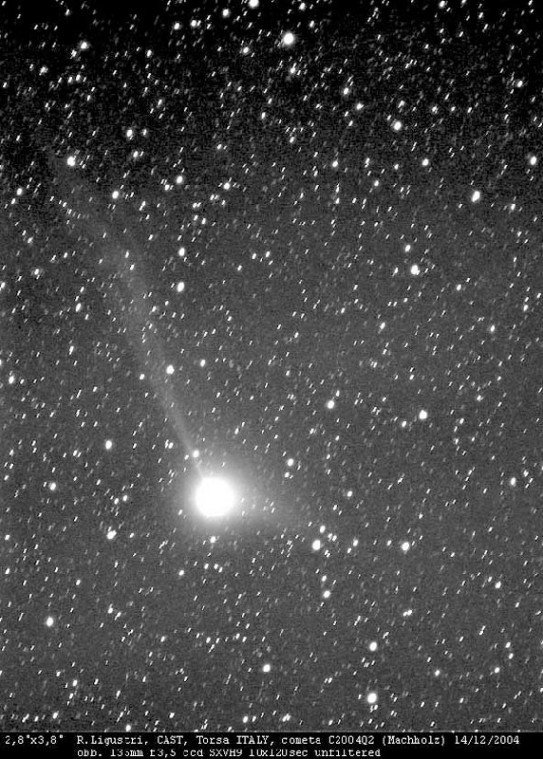By David Baumgartner
Yet another splendid comet greets us in the winter sky following
a string of comets in the past year.
Comet C/2004 Q2 (Machholz) can be found high in the northern sky
as it makes its way toward the North Star, Polaris.
By David Baumgartner
Yet another splendid comet greets us in the winter sky following a string of comets in the past year.
Comet C/2004 Q2 (Machholz) can be found high in the northern sky as it makes its way toward the North Star, Polaris. You will need binoculars living in the city, but out in the country under dark skies, you should be able to see it with the naked eye.
To find this round fuzzball, look to the right of the well-known “W” shaped constellation Cassiopeia. It should be easier to see in the first 10 days of the month when the Moon’s light won’t flood out the dim comet.
If you do have the opportunity to view from dark skies, you may be able to notice the two tails of this new comet.
One tail is a bluish color of ionized gas blowing straight out from the Sun and caused by the solar wind of charged particles, while the other tail is a yellow stream of dust caused by the tracing of its own orbit.
The comet’s tails should be easier to see this month because they are leaving the brighter background of the Milky Way in the constellations Perseus and Cassiopeia.
While you are out there observing the comet, don’t forget to take time to view one of the most spectacular objects in the sky – that of course would be Saturn.
Saturn and its beautiful rings certainly dominates the evening sky. Look for the bright yellow looking star almost halfway up in the eastern sky, not far from the constellation Gemini, the Twins.
And if you want to stay up a little late some evening, don’t forget the giant planet Jupiter and its ever changing moon patterns.
Just before midnight, this beauty rises to show off its many spenders. By the end of the month, Jupiter will be rising two hours earlier for better viewing.
Constellation of the Month: The winter sky sparkles with bright stars. Does it just seem this way because of the clear frosty air? No, the winter sky is just full of bright stars.
Just take a look at all the bright stars in the constellation Orion. Gemini, the Twins, has a couple of bright stars that are noteworthy as well. And this is our constellation of the month. Gemini may be less conspicuous than Orion, nonetheless, a well-known constellation.
To find Gemini, just draw a line from the two brightest stars in Orion (Betelgeuse and Rigel) and go east. It will point right at Gemini. You will see two very bright stars, Castor and Pollux. Gemini is the Latin word for “twins.”
The two stars are the heads of the twins, and their bodies are the two ragged lines of stars sloping down to their feet, which stand on the Milky Way. Pollux is just a little brighter, and is slightly orange in color.
In your telescope, Castor is one of the many double stars in the sky. It actually is a group of six stars close together.
Castor and Pollux were famous twin brothers in Greek legends. Castor was a wrestler and Pollux was a boxer, and together they went on many adventures.
There was hardly any difference between them, except that Castor was mortal and Pollux was immortal. When Castor was killed, Pollux was so sad that he wanted to die too, but he could not.
The gods were so impressed by their brotherly love that they let them live together in the sky forever.
I hope everyone got what they wanted for Christmas, and I hope some of those gifts were telescopes. Make sure you read all the instructions carefully. If you have any problems, give me a call; I might be able to help you out. Clear skies.
David Baumgartner is in local real estate and is an avid amateur astronomer. His Sky Watch column appears monthly.














